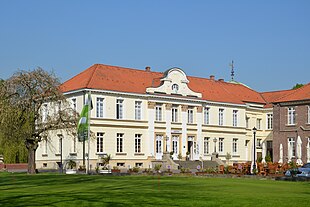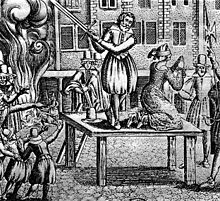Anna Spiekermann

Anna Spiekermann (also Anna Spickermann) (* around 1670 in Sutum ; † July 31, 1706 in Westerholt ) was a German maid who was the last victim of the witch hunts in Vest Recklinghausen .
Life
Anna Spiekermann was born out of wedlock to Elßken Spiekermann on her parents' Kotten in Sutum. The mother died early and all that is known about the father is that he was a soldier from Buer . The man Anna later married, Dirich Brockmann from Sutum vom Brockmannshof, worked as a soldier and fell around 1700. With their daughter, Anna Spiekermann could not find accommodation on the farm of her in-laws or with her own family, and so she moved around 1705 to her godmother and aunt, the Rheidtschen, in Westerholt. While she worked there as a maid on various farms for many years, her daughter died.
Course of the witch trial

Between 1514 and 1706 there are 127 witch trials in Vest Recklinghausen , 104 of them against women. The high point of the witch hunts were the periods 1580–1581 and 1588–1589, when the Truchsess turmoil ended. Anna Spiekermann was the last victim of the witch hunts in the vest. After 15 months in prison, she was executed by beheading on July 31, 1706. The court files are preserved in the Recklinghausen city archive .
In Westerholt, Anna Spiekermann fought against an attempted rape by a Westerholt citizen named Johannes Krampe. The latter retaliated by announcing the rumor in the village that Anna Spiekermann had robbed him of "his manhood" with a damaging spell . Krampe had already complained about his impotence and consulted doctors. Now he made Anna Spiekermann a scapegoat. On a chase through the village Anna Spiekermann was beaten up by Johannes Krampe and 20 men from the “Bachelors of Freedom Westerholt” until “there was nothing healthy about her body” and until she confessed that she had bewitched him and put a spell on his manhood applied.
When she was arrested a short time later, she vehemently retracted this confession. On April 19, 1705, she was interrogated by the judges of Freedom Westerholt . Since the statements of the plaintiff did not match those of the defendants, an interrogation of the witnesses was arranged. The witnesses interviewed, including neighbors and relatives, provided information about the defendants' reputation. Although no one could attribute negative traits such as laziness to her, everyone agreed that she must be a witch.
Her family history was stressful for the accused, the fact that her grandmother "at horst as a witch tried to throw water, and that her relatives have an evil name from their sex at Suthum". She made a confession in the torture chamber, but revoked it immediately after the torture. On January 7, 1706 she was sentenced to death by the sword and executed on the Wetterwiese (today Wetterstrasse) for “partly established, partly convinced sorcery and damage done to people and cattle”. Her "dead body" was to be cremated "as a heinous example by the executioner in public". In a long dispute over jurisdiction rights between Count Hermann Otto von Westerholt (1626–1708) and the citizens of Westerholt, the Count used the witch trial against Anna Spiekermann to demonstrate his power by choosing the place of execution. The execution site was supposed to be located on the processional route, which the citizens perceived as an abuse and defended themselves with a complaint to the electoral court in Recklinghausen. The Electorate of Cologne , however, supported the count. On the day of the execution, the count had the place besieged by 700 riflemen who had come from neighboring towns in order to publicly display his jurisdiction.
Reception history of the case of Anna Spiekermann

The journalist Kira Schmidt wrote in an article in the online magazine WAZ.de in December 2010: “They say she was the most beautiful woman in Westerholt. But precisely this beauty was her undoing. Anna Spiekermann was accused of witchcraft and sentenced to death at the stake. ”No information about beauty can be found in the documents of the witch trial. Anna Spiekermann was already 36 years old at the time of her indictment, torture and execution.
In 1924, head teacher Wilhelm Schmitt wrote a dramatic one-act play at Buerschen Gymnasium, which turned Anna Spiekermann into “Hexenänneken”, a heroine at home, and celebrated a successful premiere on July 22, 1924 at Berge Castle near Gelsenkirchen.
A historical review of the witch hunt in Vest Recklinghausen and the case of Anna Spiekermann did not take place until the 1980s and 1990s. The historian Marlies Mrotzek came to the following conclusion: “Anna Spiekermann fell victim to the delusion of witchcraft that raged in Vest Recklinghausen at the beginning of the 18th century. The unusually long process and thus her martyrdom, which lasted fifteen months, was the result of the power struggles between the feudal lords and the villagers who demanded political rights and freedoms. "
swell
Witch trial files Recklinghausen City Archives, Graeflich Westerholtes Archive, 201, BI. 72b (inspection with the consent of the count)
literature
- Wilhelm Mummenhoff: On the history of the witch hunt in the city of Recklinghausen and its surroundings during the 16th century. In: Vestische Zeitschrift . 34, pp. 75-90 (1927).
- Heinrich Dieckhöfer: Vest Recklinghausen under the government of the Electors Ernst and Ferdinand of Bavaria 1583–1650. In: Vestische Zeitschrift. 38 (1931).
- Theodor Esch: Contribution to the history of the witch trials from the city of Recklinghausen. In: Vestische Zeitschrift. Volume 11 (1901), pp. 61-78 ( online resource ).
- Gudrun Gersmann : In the footsteps of the victims - On the reconstruction of everyday female life under the impression of early modern witch persecution. In: Bea Lundt (ed.): Forgotten women on the Ruhr. From rulers and servants, housewives and witches 800-1800 . Cologne / Weimar / Vienna 1992, pp. 243-272.
- Gudrun Gersmann: "Toverie for the sake of ..." On the history of the witch persecution in Vest Recklinghausen. An overview. In: Vestische Zeitschrift. Volume 92/93 (1993/1994), pp. 7-43.
- Gudrun Gersmann: The witch as her home hero. The witch hunt of the early modern times in the sights of the home historians. In: Westphalian research. Volume 45 (1995), pp. 102-133.
- Marlies Mrotzek: Anna Spiekermann (around 1670–1706) - the last victim of the witch hunt in Vest Recklinghausen. In: Of witches, angels and other fighters. City tours on women's history in Gelsenkirchen. Gelsenkirchen 2001, pp. 75-80.
- Peter Fuchs: witch hunt on the Ruhr and Lippe. The use of justice by masters and subjects. Münster 2004, p. 40ff.
- Thomas Becks: Hexenänneken - The life of Anna Spiekermann. 2011, ISBN 978-3-8448-0692-2 .
Web links
- Kira Schmidt: The most beautiful woman in the village . Online on derWesten.de from February 4, 2013.
- Women's rupture story Anna Spiekermann
- Gelsenkirchen Agenda21 Anna Spiekermann
- Photo of the execution site on Wetterstrasse
- List of the names of the victims of the witch trials in Vest Recklinghausen (PDF; 19 kB)
| personal data | |
|---|---|
| SURNAME | Spiekermann, Anna |
| ALTERNATIVE NAMES | Spickermann, Anna |
| BRIEF DESCRIPTION | German witch trial victim |
| DATE OF BIRTH | around 1670 |
| PLACE OF BIRTH | Sutum |
| DATE OF DEATH | July 31, 1706 |
| Place of death | Westerholt |